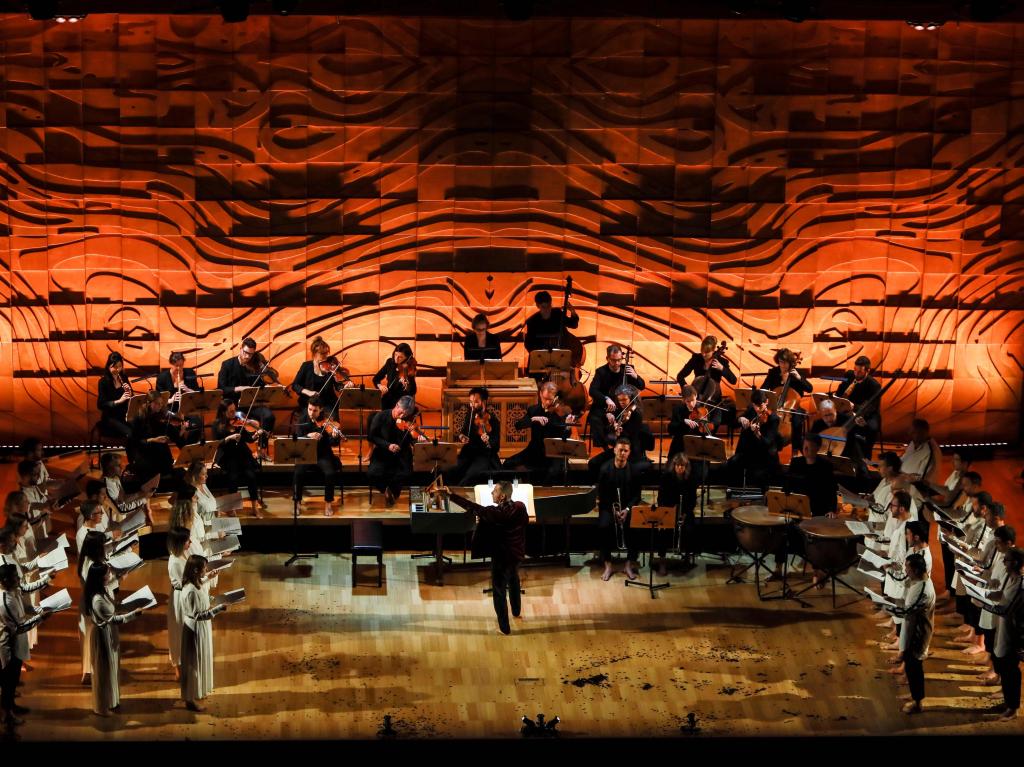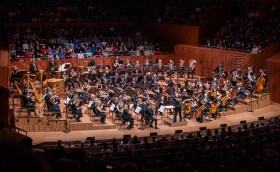The Brandenburg Choir. Photograph (c) Steven Godbee.
Paul Dyer has opened the Australian Brandenburg Orchestra’s Season with a splash. In the ensemble’s first performance of this immensely popular work, Dyer has rethought Handel’s most loved oratorio as both a musical and theatrical spectacle. In doing so he has worked with three graduates from NIDA (Constantine Costi, Genevieve Graham and Charlotte Mungomery) on staging and costuming. The work is in three parts though it is here fashioned into four abstract tableau each matched with an early Baroque painting reproduced in the printed program that Dyer claims have an ‘almost cinematic quality…traversing the tension between darkness and light, and dream and reality’: The Calling of Saint Matthew and The Seven Works of Mercy by Caravaggio, the Triumph of Bacchus by Velázquez and The Complete Reconciliation of the Queen and her Son by Rubens.
The work was first performed in Dublin in 1741 to benefit homeless children, and Handel was involved in directing some 36 subsequent performances. It seems he changed the instrumentation and vocal parts, adding and cutting numbers to suit the needs of each performance. ‘Authenticity’ or ‘as originally performed’, therefore, becomes more problematic. The excellent text by Charles Jennens impressively and comprehensively incorporates the main tenets of Christianity using excerpts from the Bible and Prayer Book Psalter.
Dramatization of Handel’s oratorios is not new. René Jacobs for one has been doing this for some time, notably with his 2008 staging of Belshazzar for the Aix-en-Provence festival, but this was the first Messiah I have seen semi-staged. I pondered beforehand how the work could be transformed into opera when there are no roles nor indeed any plot, and when the main subject, Jesus, is absent. Would there be a risk that theatrical interpretation distracts the listener from the extraordinary score? In seeking a narrative could the staging and dramaturgy overwhelm or even trivialise the composition? On the other hand it seems reasonable to dramatically interpret this long sequence of choruses, recitatives, arias and orchestral passages, given the subject matter brims with dramatic biblical events. The work certainly was first performed in theatres and not churches.
A principal flaw in this production was the placement of the orchestra up stage on rises with the conductor’s podium in front, while soloists and choir performed front of stage and thus behind the conductor. Despite Dyer regularly stepping backwards to catch their attention and the singers occasionally glancing over their shoulders this was all far from ideal. Lighting by Peter Dubie was dramatic though in this performance spots took time to find the soloist and the choir struggled on occasion to read its music in near darkness. The costume concept by Genevieve Graham and Charlotte Mungomery presented the choir in simple white smocks and black belts with the soloists mostly dressed in further black and white. A sole red scarf is effectively used to depict the Saviour mocked and scorned in the aria He was Despised.
All four soloists were interesting and individual artists. Soprano Lucia Martín Cartón had a clean and expressive voice with an edge, using a shimmering vibrato here and there. Greek falsettist Nicholas Spanos has an impressive range and an attractive, pure tone though had problems in the break between chest (or natural) voice and his falsetto range particularly in But who may abide the day of his coming. He was consistently flat throughout He was despised and the vocal gymnastics of the centre sections of both arias were fudged. A miscalculation in O thou that tellest good tidings to Zion disappointed. American tenor Kyle Bielfield (now Sydney-based) has a most impressive voice and is a good actor. The pathos of his Behold and see if there be any sorrow was deeply moving. Australian David Greco has a fine bass voice though his occasional shouts were unwarranted. His excellent duet with Leanne Sullivan in The trumpet shall sound, however, more than compensated. I did not enjoy, however, the apparently unrestrained ‘ornamentation’ by all four soloists. As the work progressed it became almost a competition to indulgently out-embellish each other often resulting in tasteless and unwanted cadenzas.
Some love and some simply put up with Dyer’s flamboyant conducting. Often it would seem it services no purpose whatever, while his musicians take but scant notice. Throughout this performance his gestures ranged from maniacal tantrums to ballet.
The Brandenburg Choir was the star of the night. At full throttle, they provide a glorious sound. For its size of 28 singers I have not heard better in the country.
Rating: 4 stars out of 5
Handel’s Messiah
Australian Brandenburg Orchestra
Brandenburg Choir
Paul Dyer, artistic director
Constantine Costi, staging
Genevieve Graham, costume concept
Charlotte Mungomery, costume concept
Peter Dubie, lighting
Presented by Australian Brandenburg Orchestra





